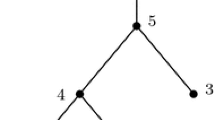Abstract
We propose a new family of interconnection networks (WG n m) with regular degree three. When the generator set is chosen properly, they are isomorphic to Cayley graphs on the wreath product Z m ≀ S n . In the case of m ≥ 3 and n ≥ 3, we investigate their different algebraic properties and give a routing algorithm with the diameter upper bounded by \(\lceil\frac{m}{2}\rceil (3n^2-8n+4)-2n+1\). The connectivity and the optimal fault tolerance of the proposed networks are also derived. In conclusion, we present comparisons of some familiar networks with constant degree 3.
Similar content being viewed by others
References
S. B. Akers and B. Krishnamurthy, A group-theoreticmodel for symmetric interconnection networks, IEEE Trans. on Computers, 1998, 38(4): 556–566.
L. Bhuyan and D. P. Agrawal, Generalized hypercube and hyperbus structure for a computer network, IEEE Trans. on Computers, 1984, 33(3): 323–333.
K. Qiu, S. G. Akl, and H. Merjer, On some properties and algorithms for the star and pancake interconnection networks, Journal of Parallel and Distributed Computing, 1994, 22(1): 33–45.
S. Lakshmivarahan, J. S. Jwo, and S. K. Dhall, Symmetry in interconnection networks based on Cayley graphs of Permutations: A survey, Parallel Computing, 1993, 19: 361–407.
F. Preparata and J. Vuillemin, The Cube-Connected cycles versatile network for parallel computation, Comm ACM, 1981, 24(5): 30–39.
S. Latifi and P. K. Srimani, A fixed degree regular network for massively paralled system, Journal of Supercomputing, 1998, 12: 277–291.
Chi-Hsiang Yeh and Emmanouel A.Varvarigo, Parallel algorithms on the rotation-exchange network–A trivalent variant of the star graph, in Proc. Symp. Frontiers of Massively Parallel Computation, 1999, 1: 302–309.
P. Vadapalli and K. Srimani, A new family of Cayley graph interconnection network of constant degree four, IEEE Trans. on Parallel and Distributed Systems, 1996, 7(1): 26–32.
D. S. L. Wei, F. P. Muga, and K. Naik, Isomorphism of degree four Cayley graph and wrapped butterfly and their optimal permutation routing Algorithm, IEEE Trans. on Parallel and Distributed Systems, 1999, 10(11): 1290–1298.
P. Vadapalli and K. Srimani, Trivalent Cayley graphs for interconnection networks, Information Processing Letters, 1995, 54: 329–335.
C. Hoffman, Group Theoretic Algorithm and Graph Isomorphism, New York, Springer-Verlag, 1982.
D. K. Pradhan, Fault-tolerance multiprocessor link and bus network architectures, IEEE Trans. on Computers, 1985, 34(1): 33–45.
A. W. Fu and Siu-Cheung Chau, Cyclic-Cubes: A new family of interconnection networks of even fixed-Degress, IEEE Trans. on Parallel and Distributed Systems, 1996, 9(12): 1253–1268.
Author information
Authors and Affiliations
Corresponding author
Additional information
This work was partly supported by the Natural Science Foundation of Fujian Education Ministry under Grant No. JB05333.
Rights and permissions
About this article
Cite this article
Zhou, S. A New Family of Trivalent Cayley Networks on Wreath Product Z m ≀S n . Jrl Syst Sci & Complex 19, 577–585 (2006). https://doi.org/10.1007/s11424-006-0577-3
Received:
Revised:
Issue Date:
DOI: https://doi.org/10.1007/s11424-006-0577-3




